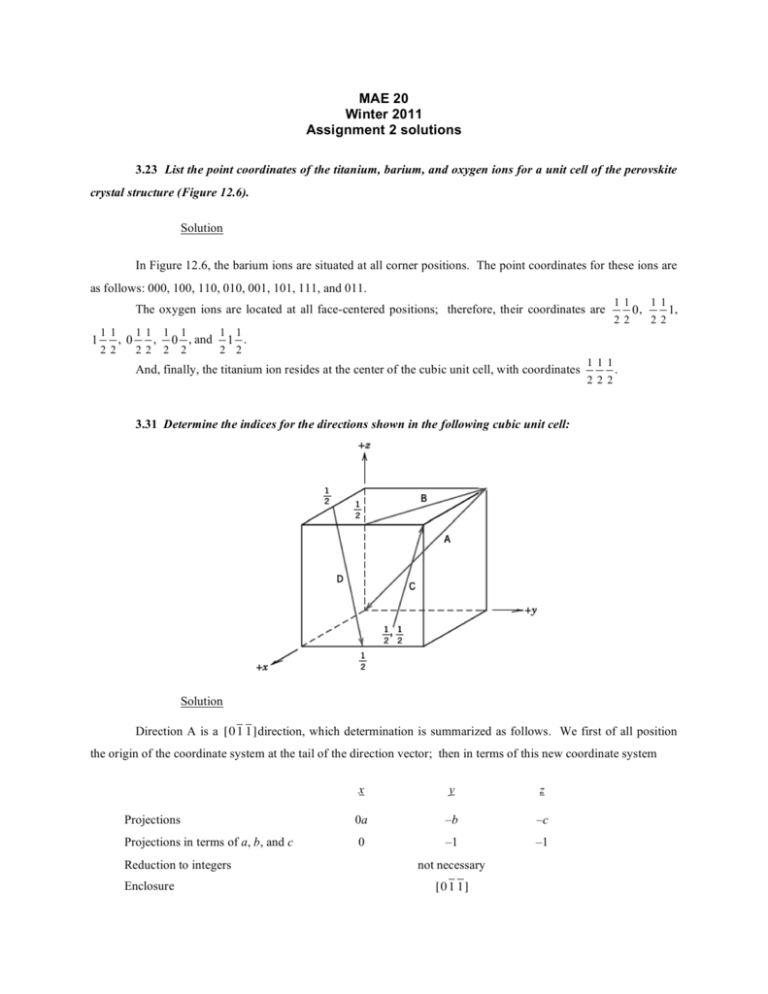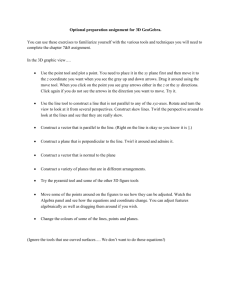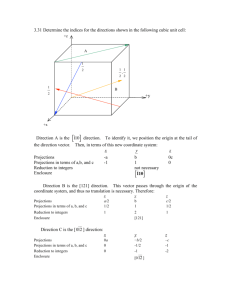Assignment 2 solutions
advertisement

MAE 20 Winter 2011 Assignment 2 solutions 3.23 List the point coordinates of the titanium, barium, and oxygen ions for a unit cell of the perovskite crystal structure (Figure 12.6). Solution In Figure 12.6, the barium ions are situated at all corner positions. The point coordinates for these ions are as follows: 000, 100, 110, 010, 001, 101, 111, and 011. The oxygen ions are located at all face-centered positions; therefore, their coordinates are 1 11 22 , 0 11 22 , 1 2 1 1 1 2 2 2 0 , and 11 22 0, 11 22 1, 1 . And, finally, the titanium ion resides at the center of the cubic unit cell, with coordinates 111 222 . 3.31 Determine the indices for the directions shown in the following cubic unit cell: Solution Direction A is a [0 1 1 ] direction, which determination is summarized as follows. We first of all position the origin of the coordinate system at the tail of the direction vector; then in terms of this new coordinate system x y z Projections 0a –b –c Projections in terms of a, b, and c 0 –1 –1 Reduction to integers Enclosure not necessary [0 1 1 ] Direction B is a [ 210] direction, which determination is summarized as follows. We first of all position the origin of the coordinate system at the tail of the direction vector; then in terms of this new coordinate system x Projections –a Projections in terms of a, b, and c –1 Reduction to integers –2 Enclosure y b 2 1 2 1 z 0c 0 0 [ 210] Direction C is a [112] direction, which determination is summarized as follows. We first of all position the origin of the coordinate system at the tail of the direction vector; then in terms of this new coordinate system Projections Projections in terms of a, b, and c Reduction to integers x y a 2 1 b 2 1 2 2 1 1 Enclosure z c 1 2 [112] Direction D is a [112 ] direction, which determination is summarized as follows. We first of all position the origin of the coordinate system at the tail of the direction vector; then in terms of this new coordinate system Projections Projections in terms of a, b, and c Reduction to integers x y a 2 1 b 2 1 2 2 1 1 Enclosure [112 ] 3.40 Sketch within a cubic unit cell the following planes: (a) (01 1 ) , (e) (1 11 ) , (b) (112 ) , (f) (12 2 ) , (c) (102 ) , (g) (1 23 ) , z –c –1 –2 (d) (13 1) , (h) (01 3 ) Solution The planes called for are plotted in the cubic unit cells shown below. 3.42 Determine the Miller indices for the planes shown in the following unit cell: Solution For plane A we will move the origin of the coordinate system one unit cell distance to the upward along the z axis; thus, this is a (322) plane, as summarized below. x y z a b 3 2 Intercepts in terms of a, b, and c 1 1 3 2 Reciprocals of intercepts 3 2 Intercepts Reduction (not necessary) Enclosure (322) c – 2 1 – 2 –2 For plane B we will move the original of the coordinate system on unit cell distance along the x axis; thus, this is a (1 01) plane, as summarized below. x a y z ∞b c Intercepts – Intercepts in terms of a, b, and c – Reciprocals of intercepts –2 0 2 Reduction –1 0 1 Enclosure 2 1 2 ∞ 2 1 2 (1 01) 3.53 (a) Derive linear density expressions for BCC [110] and [111] directions in terms of the atomic radius R. (b) Compute and compare linear density values for these same two directions for tungsten. Solution (a) In the figure below is shown a [110] direction within a BCC unit cell. For this [110] direction there is one atom at each of the two unit cell corners, and, thus, there is the equivalence of 1 atom that is centered on the direction vector. The length of this direction vector is denoted by x in this figure, which is equal to z 2 ! y2 x= where y is the unit cell edge length, which, from Equation 3.3 is equal to 4R . Furthermore, z is the length of the 3 unit cell diagonal, which is equal to 4R Thus, using the above equation, the length x may be calculated as follows: x= " %2 # & 4R (4R) 2 ! $$ '' 3 = 32 R 2 2 = 4R 3 3 Therefore, the expression for the linear density of this direction is LD110 = number of atoms centered on [110] direction vector length of [110] direction vector = 3 1 atom = 2 4R 2 4R 3 A BCC unit cell within which is drawn a [111] direction is shown below. For although the [111] direction vector shown passes through the centers of three atoms, there is an equivalence of only two atoms associated with this unit cell—one-half of each of the two atoms at the end of the vector, in addition to the center atom belongs entirely to the unit cell. Furthermore, the length of the vector shown is equal to 4R, since all of the atoms whose centers the vector passes through touch one another. Therefore, the linear density is equal to LD111 = number of atoms centered on [111] direction vector length of [111] direction vector = 2 atoms 1 = 4R 2R (b) From the table inside the front cover, the atomic radius for tungsten is 0.137 nm. Therefore, the linear density for the [110] direction is LD110 (W) = 3 4R 2 = 3 = 2.23 nm!1 = 2.23 " 10 9 m!1 (4)(0.137 nm) 2 While for the [111] direction LD111 (W) = 1 1 = = 3.65 nm!1 = 3.65 " 10 9 m!1 2 R (2)(0.137 nm) 3.54 (a) Derive planar density expressions for FCC (100) and (111) planes in terms of the atomic radius R. (b) Compute and compare planar density values for these same two planes for nickel. Solution (a) In the figure below is shown a (100) plane for an FCC unit cell. For this (100) plane there is one atom at each of the four cube corners, each of which is shared with four adjacent unit cells, while the center atom lies entirely within the unit cell. Thus, there is the equivalence of 2 atoms associated with this FCC (100) plane. The planar section represented in the above figure is a square, wherein the side lengths are equal to the unit cell edge length, 2R 2 (Equation 3.1); and, thus, the area of this square is just (2R 2 ) 2 = 8R2. Hence, the planar density for this (100) plane is just PD100 = number of atoms centered on (100) plane area of (100) plane = 2 atoms 8R 2 = 1 4R 2 That portion of an FCC (111) plane contained within a unit cell is shown below. There are six atoms whose centers lie on this plane, which are labeled A through F. One-sixth of each of atoms A, D, and F are associated with this plane (yielding an equivalence of one-half atom), with one-half of each of atoms B, C, and E (or an equivalence of one and one-half atoms) for a total equivalence of two atoms. Now, the area of the triangle shown in the above figure is equal to one-half of the product of the base length and the height, h. If we consider half of the triangle, then (2 R) 2 + h 2 = (4 R) 2 which leads to h = 2 R 3 . Thus, the area is equal to Area = 4 R(h) (4 R) (2 R 3 ) = = 4 R2 3 2 2 And, thus, the planar density is PD111 = number of atoms centered on (111) plane area of (111) plane = 2 atoms 4 R2 3 = 1 2 R2 3 (b) From the table inside the front cover, the atomic radius for nickel is 0.125 nm. Therefore, the planar density for the (100) plane is PD100 (Ni) = 1 1 = = 16.00 nm!2 = 1.600 " 1019 m!2 2 4R 4 (0.125 nm) 2 While for the (111) plane PD111 (Ni) = 1 2 R2 3 = 1 = 18.48 nm!2 = 1.848 " 1019 m!2 2 3 (0.125 nm) 2 3.66 Figure 3.25 shows the first four peaks of the x-ray diffraction pattern for copper, which has an FCC crystal structure; monochromatic x-radiation having a wavelength of 0.1542 nm was used. (a) Index (i.e., give h, k, and l indices) for each of these peaks. (b) Determine the interplanar spacing for each of the peaks. (c) For each peak, determine the atomic radius for Cu and compare these with the value presented in Table 3.1. Solution (a) Since Cu has an FCC crystal structure, only those peaks for which h, k, and l are all either odd or even will appear. Therefore, the first peak results by diffraction from (111) planes. (b) For each peak, in order to calculate the interplanar spacing we must employ Equation 3.13. For the first peak which occurs at 43.8° d111 = n! (1)(0.1542 nm) = = 0.2067 nm # 43.8° & 2 sin " (2)%sin ( $ 2 ' (c) Employment of Equations 3.14 and 3.1 is necessary for the computation of R for Cu as R = = a 2 2 = (dhkl ) (h) 2 + (k) 2 + (l) 2 2 2 (0.2067 nm) (1) 2 + (1) 2 + (1) 2 2 2 = 0.1266 nm Similar computations are made for the other peaks which results are tabulated below: Peak Index 2θ d (nm) hkl R (nm) 200 50.8 0.1797 0.1271 220 74.4 0.1275 0.1275 311 90.4 0.1087 0.1274







